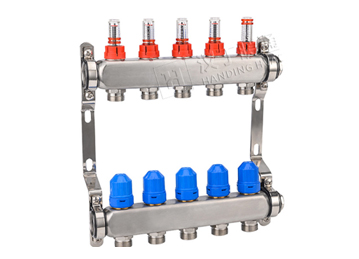 February 05, 2025
February 05, 2025A stainless - steel heating manifold is a crucial component in many heating systems, especially in hydronic heating setups. To ensure its efficient operation and extend its lifespan, proper maintenance is essential. Here are some valuable maintenance tips.

1. Regular Visual Inspections
1.1 Exterior Examination
Perform a visual inspection of the stainless - steel heating manifold at least once a month. Check for any signs of corrosion, even though stainless steel is highly resistant. Look for discoloration, rust spots, or pitting on the surface. These could be early indicators of potential issues. Also, inspect the connections between the manifold and the pipes. Ensure that there are no loose fittings, as this can lead to leaks, which not only waste energy but also cause damage to the surrounding areas.
1.2 Gasket and Seal Inspection
Inspect the gaskets and seals on the manifold. These components are responsible for preventing leaks at the joints. Over time, gaskets can dry out, crack, or become brittle. If you notice any signs of damage to the gaskets or seals, such as visible cracks or a loss of elasticity, they should be replaced immediately. Using high - quality replacement gaskets and seals is crucial to maintain a tight seal.
2. Cleaning and Flushing
2.1 Regular Cleaning
Periodically clean the exterior of the heating manifold. Dust, dirt, and debris can accumulate on the surface, which may affect its heat - transfer efficiency. Use a soft, non - abrasive cloth or a mild detergent solution to clean the surface. Avoid using harsh chemicals or abrasive cleaners, as they can scratch the stainless - steel surface and potentially damage its corrosion - resistant properties.
2.2 System Flushing
Flush the heating system, including the manifold, at least once a year. This helps to remove any sediment, rust, or other contaminants that may have built up inside the pipes and the manifold. Flushing can be done using a specialized flushing agent according to the manufacturer's instructions. A clean system ensures better flow rates and prevents blockages, which can put additional stress on the manifold and reduce its lifespan.
3. Pressure Monitoring
3.1 Install a Pressure Gauge
Install a pressure gauge on the heating system near the manifold. Regularly monitor the pressure to ensure it remains within the recommended operating range. Abnormal pressure levels can indicate problems such as a blocked pipe, a malfunctioning pump, or a faulty expansion tank. High pressure can cause stress on the manifold, leading to leaks or even failure, while low pressure can result in inefficient heating.
3.2 Pressure Adjustment
If the pressure is too high or too low, take appropriate measures to adjust it. For example, if the pressure is too high, you may need to bleed the system to release some of the excess pressure. If it's too low, check for leaks and add more water to the system as needed. Always follow the proper procedures for pressure adjustment to avoid any safety hazards.
4. Protect Against Freezing
4.1 Insulation
In cold climates, proper insulation is crucial to prevent the heating manifold from freezing. Insulate the manifold and the connected pipes with high - quality insulation materials. This helps to maintain the temperature of the water inside the system and prevents it from dropping below the freezing point. Frozen water can expand and cause the manifold to crack or burst, leading to costly repairs.
4.2 Anti - Freeze Solutions
If there is a risk of freezing, consider using an anti - freeze solution in the heating system. However, make sure that the anti - freeze solution is compatible with the stainless - steel components of the manifold. Some anti - freeze solutions can cause corrosion if they are not suitable for stainless steel.
5. Professional Maintenance
5.1 Annual Servicing
Arrange for an annual professional servicing of the heating system, including the stainless - steel heating manifold. A qualified technician can perform a more in - depth inspection, including checking the internal components of the manifold if possible. They can also perform any necessary repairs, such as replacing worn - out parts or adjusting the system settings for optimal performance.
5.2 Training and Certification
If you are responsible for maintaining the heating manifold, consider getting training and certification in heating system maintenance. This will give you the knowledge and skills to perform proper maintenance and troubleshooting, ensuring that the manifold operates at its best for as long as possible.
In conclusion, by following these maintenance tips, you can significantly prolong the lifespan of your stainless - steel heating manifold. Regular inspections, cleaning, pressure monitoring, freeze protection, and professional servicing are all key elements in keeping the manifold in good working condition and ensuring the efficient operation of your heating system.
GET A QUOTE